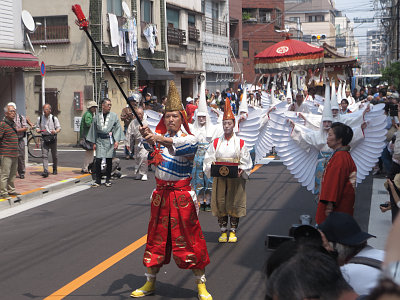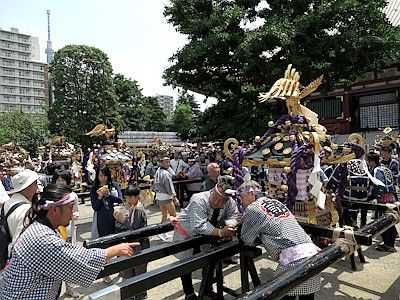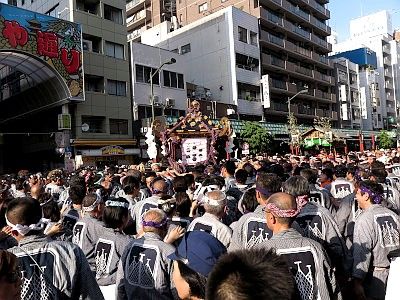Sensoji Temple
 Sensoji (浅草寺) is a Buddhist temple located in the Asakusa district of Tokyo. Asakusa is an area known for its nostalgic Shitamachi atmosphere, and Sensoji Temple, together with Asakusa Shrine situated next to the temple, is the centerpiece of the area.
Sensoji (浅草寺) is a Buddhist temple located in the Asakusa district of Tokyo. Asakusa is an area known for its nostalgic Shitamachi atmosphere, and Sensoji Temple, together with Asakusa Shrine situated next to the temple, is the centerpiece of the area.
Sensoji Temple is said to be founded in the 7th century, allowing it to claim the title of the oldest Buddhist temple in Tokyo, though most of its main buildings are newly erected with concrete after they were burnt down in WWII.
Sensoji belonged to the Tendai school until then, but after the war, it broke away from the school to set up its own.


Kaminarimon Gate is the first gate to Sensoji. On the front side, the statue of Fujin (god of wind) stands on the right and the statue of Raijin (god of thunder) on the left.
On the back side, on the right stands the statue of Tenryu and on the left Kinryu. Tenryu and Kinryu are dragon gods but are in the form of humans here. They are placed here as guardians.


Hozomon Gate houses a pair of Nio figures on the front side. Nio are guardian deities whose statues are often erected in the entrance of a temple.

Hondo is the main hall of the temple. It is dedicated to Kannon Bosatsu, a Buddhist god (or goddess - its gender is unknown) of mercy, so the building is also called Kannondo.


Nitenmon Gate is one of a handful of buildings that survived WWII. It was constructed in around 1649 as a gate for Asakusa Toshogu Shrine, which doesn't exist now. This gate is designated as an Important Cultural Property.

Yogodo is where Buddhist divinities who support Kannon Bosatsu are enshrined.

This stone bridge was created for Asakusa Toshogu Shrine in 1618.

Awashimado is a spiritual branch of Awashima Shrine in Wakayama Prefecture. Awashima Myojin enshrined here is a deity who is said to protect women.

Hashimoto Yakushido, built in 1649, is dedicated to Yakushi Nyorai. Yakushi Nyorai is a Budhist divinity of medicine.

Bentendo is where Benzaiten is enshrined. Benzaiten is a Buddhist goddess of music, dance and fortune. Shoro is the building a huge bell is hung to announce time at 6AM every morning.


This Hokyoin'to was erected in 1761.
Denboin
Denboin, which is adjacent to Sensoji's main precincts, is the temple office and also the residence of the top monk of Sensoji.
Unlike the main part of Sensoji, this area managed to avoid the air strikes of the Second World War and preserves a Japanese stroll garden and buildings built before the war. The garden is designated as a Place of Scenic Beauty, and many of the buildings which survived the war are listed as Important Cultural Properties.
This place was not open to the public previously, but since 2012, from mid-March to early May, it is on exhibit every year, together with Oema Museum, for 300 yen. Oema Museum is a small museum displaying large ema pictures dedicated to Sensoji, though you're not allowed to take photos of them.
If you are unable to visit Sensoji in this period, too bad you can't see the garden fully, but you can take a glimpse of it through the fence from here. (Only a little bit, sorry!)






Asakusa Shrine
Asakusa Jinja (浅草神社), located next to Sensoji Temple, is a rather small Shinto shrine which honors three commoners who were engaged in the foundation of Sensoji. It had been part of the temple for a long time, though it's run independently now. Unlike Sensoji, its main buildings constructed in the feudal times survived WWII and is now designated as Important Cultural Properties.



Haiden, constructed in 1649, is where you offer prayers.

Honden, constructed in 1649, is where the divinities are enshrined.
Events at Sensoji & Asakusa Jinja
Described below are some notable annual events at Sensoji and Asakusa Shrine
New Year - Joya-no-kane & Hatsumoude
Joya-no-kane (除夜の鐘) is a popular ritual to ring the huge bell of a temple, usually 108 times, when the New Year arrives. At Sensoji, ordinary people cannot ring the bell.
Hatsumode (初詣) is also a popular custom which people pay visit to Shinto shrines and major Buddhist temples when the New Year arrives to offer their first prayers of the year. Sensoji attracts more than 2 million people in the first three days of January, second only to Meiji Jingu Shrine in Tokyo Prefecture.



Jan 18 - Moja Okuri
The Moja Okuri (亡者送り) is the last piece of a week-long ritual called Onza Hiho Darani-e, which is held from January 12 through 18 exclusively by monks and is entirely undisclosed to outsiders. Only the last part called Moja Okuri is open to the public. On the evening of Jan 18th (usually about 6pm), two men disguised as evil spirits stroll around the temple precincts, hitting torches in their hands at the ground. People flock to pick up pieces of the torches as lucky charms. In the end, the two throw the torches in a hole to pacify hungry spirits in the hell. This process lasts only about ten minutes or so, though.


Feb 3 - Setsubun Bean-throwing
On Setsubun Day (Feb 3), the day before the arrival of spring, many Shinto shrines and large Buddhist temples hold a ceremony which throw beans to drive away evil spirits and invite good luck (節分会豆まき). Sensoji is one of the most famous sites for this event. At around 10:30am, kindergarteners throw beans. At 0:00pm and 2:00pm, ordinary people who applied beforehand do bean-throwing. And at 4:00pm, 4:20pm, 4:40pm, & 5:00pm, celebrities throw beans.
Bean-throwing event is conducted also at adjoining Asakusa Shrine.



Mar 17-18 - Honzon-jigen-e
Honzon-jigen-e (本尊示現会) is a ceremony to commemorate the foundation of Sensoji Temple back in 628CE. On March 18th of 628, the statuette of Sho-Kannon, now enshrined in the main hall of Sensoji, was caught in a fishing-net by three commoners. So on the evening fo March 17, three mikoshi (portable shrines) of Asakusa Shrine, which enshrine the three commoners, are carried into the main hall of Sensoji and stay overnight there to reunite with the statuette. For details about this event, see the article on Honzon-jigen-e.
On March 18th, held as well is the Reitaisai (annual grand festival) of Hikan Inari Shrine located in the northeastern corner of Asakusa Shrine's precincts. In this event, several performances will be dedicated to this small shrine.



Asakusa Kodomo Kabuki Matsuri
In March, for several days around weekends, Asakusa Kodomo Kabuki Matsuri (浅草こども歌舞伎まつり), literally meaning "Children's Kabuki Festival," is held at the Kaguraden stage of the shrine. For details about this event, see the article on Asakusa Kodomo Kabuki Matsuri.

Apr 8 - Hana Matsuri
Hana Matsuri (花まつり), literally meaning the Flower Festival, is a name for the event to celebrate Buddha's birthday. Visitors pour amacha tea on a small Buddha statuette depicting the birth of the Buddha.


Mid-May - Sanja Matsuri
Sanja Matsuri (三社祭) is the annual grand festival of Asakusa Shrine held from Friday through Sunday nearest to May 17. This is one of the largest traditional festivals in Tokyo. The term sanja comes from Sanja Gongen, which was the former name of Asakusa Shrine. For details about this event, see the article on Sanja-matsuri.


early Jul - Natsu-moude
Natsu-moude (夏詣), which is conducted in the first week of July, is a pretty new event Asakusa Shrine is advocating. Since it is close to Tanabata Day, the precincts are adorned with tanabata decorations, and concerts and performances are held in some of the days.


Jul 9-10 - Bladder Cherry Market
Open-air markets of bladder cherries (ほおずき市) are not so uncommon among Buddhist temples, but the one held at Sensoji is the most famous. It is said that bladder cherries began to be sold as herbal medicines.

Dec 17-19 - Toshi-no-ichi Market
Toshi-no-ichi (歳の市) Markets are the last open-air market of the year, usually selling new year goods. At Sensoji, what are sold at stalls are hagoita. A hagoita is a wooden racket which is used for hanetsuki, a game resembling badminton but without a net, and is played in the New Year.
